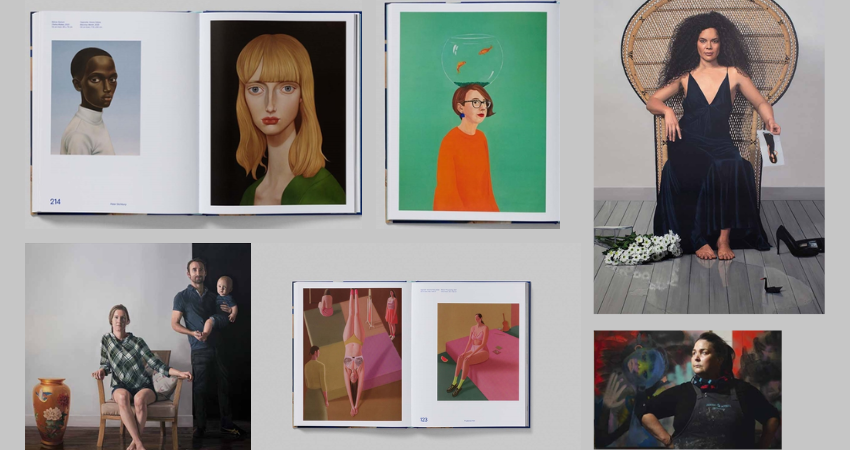Review: About Face, Amber Creswell Bell, Thames & Hudson
The shadow of the Archibald Prize looms large in this coffee-table book about contemporary Australian portraiture painting (an essential addition to Amber Creswell Bell’s recent surveys of contemporary Australian art in various genres). Artists have mixed feelings about the prize. But most are grateful for the exposure it gives to local artists, first, and to the genre of portraiture, which some artists feel is otherwise not as embraced by the public as, say, landscape.
Painter David Darcy describes the Archibald as a ‘spectacle’, and some are uncomfortable with placing portrait painting into a competitive setting, like sport. Yet others enthuse about its egalitarian aspects and the fact that, at least for a moment each year, high art is celebrated and discussed in the mainstream. For some, like Blak Douglas, painter of large canvasses of Indigenous subjects and pop art elements, the Archibald is a way into the fine art scene.
David Fairbairn, whose vibrantly linear paintings owe much to Giacometti and Auerbach, suggests that the judges and viewing public prioritise realism, thinking ‘a good likeness’ is paramount, and that other qualities are neglected. Ben Quilty, however, sees the public as more sophisticated than is often assumed, arguing that Australians are happy to be challenged by art. The prize is an indication that despite the availability and ubiquity of photographs – and we have some great photographers – we value the power of painting to provide insights into personality.
Most portrait painters talk here, in one way or another, about capturing some essence of the person being painted, but they do this in widely varying ways, and they also at times acknowledge the challenges of doing so. David Darcy, who creates hyperrealist works, likes to paint from photos, which gives him time to test out varying approaches. Besides, as more than one painter acknowledges, people just don’t have the time to sit for days. And yet others insist on at least starting a painting with a live sitter, possibly because when painting a photograph, the artist is already one step removed.
Many of the artists here are working in the hyperrealist genre, Jonathan Dalton insanely so, including hard-to-paint details like rattan and water on floorboards, as if responding to a challenge. But these details also add extra insight into the stories of the characters he is painting. Tessa Mackay has an extraordinary portrait of David Wenham seen through a shop window, with all the requisite blurred reflections, fabric folds and light on glass that 1970s photorealists such as Richard Estes adored.
Hyperrealism is sometimes criticised as just an exercise in cleverness, where technique becomes the main subject, but some artists relish the details as adding extra insight into a person’s personality and history. Dee Copeland is one who extols the virtues of wrinkles: ‘I love the hidden stories that are woven into every wrinkle’. Tessa Mackay suggests that her detailed portraits simultaneously allow us a ‘heightened window’ into the personality of the sitter and insights into general human experience.
Archer Davies argues that portraits say something about the relationship between painter and sitter, the latter remaining somewhat enigmatic. Graeme Drendel describes this relationship as ‘confrontational’. Natasha Walsh, whose art graces the cover of this book, suggests that a portrait is primarily about the painter, especially since the art of portraiture is so subjective. This may make more sense, or minimise the difficulty, when she is painting herself, as in the examples in this book, where she inserts herself into well-known paintings by Whiteley and Klimt.
Artists such as Prudence Flint and Monica Rohan suggest that personality comes through much more than studying a face. In Flint’s work, which tends to be more figurative than portrait, and has the smoothness and distortions of John Brack’s work, her characters tend to have minimised heads, and she evokes mood, though it is often guarded, through the depiction of the whole body and its setting. Rohan argues that all aspects of a painting reflect personality, including style and context. Most of her paintings situate her subjects in large garden settings.

This book displays both the breadth of the skill of Australian portrait painters and the appeal of portraiture. While one painter questions whether Australians cope with having a stranger’s portrait on the wall, Dee Copeland thinks we have a perennial interest in the way faces (and bodies) convey personality, and therefore portraits hold a viewer’s attention, whether of stranger or friend.
Nick Mattiske blogs on books at coburgreviewofbooks.wordpress.com and is the illustrator of Thoughts That Feel So Big.











